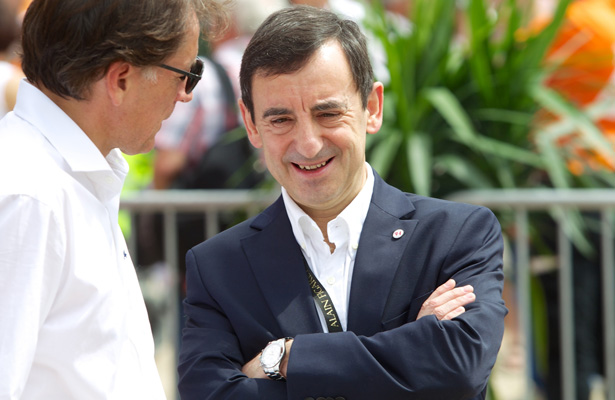
Photo: John Dagys
While FIA World Endurance Championship teams are on their summer break, the FIA and ACO continue to work towards the future, with new and evolving prototype classes, as well as continued talks on the proposed new-for-2016 GTE regulations. (En Français)
ACO President Pierre Fillon, who was on hand at last weekend’s European Le Mans Series round at the Red Bull Ring for the launch of the LMP3 class, has taken a keen interest on the growth of LMP1, particularly on ensuring its long-term success in both the hybrid (LMP1-H) and lightweight (LMP1-H) categories.
“We’re putting everything in place to attract more manufacturers,” Fillon told Endurance-Info in an exclusive interview with Laurent Mercier. “I also prefer that we speak about non-hybrid LMP1 rather than LMP1-L.
“The ACO and FIA want different technologies. There’s the LMP1-H category with petrol-powered Porsche and Toyotas and the diesel-powered Audi.
“The non-hybrid class is also made for manufacturers. We currently have Rebellion and we will have Lotus [beginning in] Austin.
“The goal is to keep the two classes as close [in performance] as possible. If LMP1-H should be in trouble, it must benefit from the cars in the ‘Light’ class. We will ensure this balance.
“Rebellion must wait a little bit because the car is only at the beginning of its development. We hope to see an OAK LMP1-L, while other manufacturers are also interested.”
While there’s a clear-cut formula moving forward in LMP1, the story is a bit different in LMP2, with the debate continuing on whether or not to drop the P2 driver categorization rules in the FIA WEC next year.
The cost-capped class has struggled for entries in 2014, with only four P2 cars expected again for the next round at COTA.
“We raised the question of what to do with LMP2,” Fillon said. “We are seeing a rebalancing of the category with more cars in the ELMS but less in the FIA WEC.
“The category is open to gentlemen drivers but it’s difficult for them to take off an entire week [from work] and travel to the other end of the world. Most gentlemen drivers have businesses to support.
“We need to reduce the costs of LMP2 in the FIA WEC and also attract young drivers coming from GP2 or World Series by Renault.
“However, we are not determined to abolish the driver categorization system or set up LMP2-Pro and LMP2-Am, which would be too complicated to understand.”
The ACO, FIA and IMSA, meanwhile, continue their talks for a common set of P2-style regulations for 2017, which would be embraced in the TUDOR United SportsCar Championship as well as the other ACO-backed series.
It’s understood that the class will be based around the current LMP1-grade tub and safety structures, with the possibility of engine manufacturer-specific bodywork, similar to what’s been seen with Daytona Prototypes in the U.S.
“The technical teams are especially working closely for 2017,” Fillon said. “The idea is to focus on the new LMP2 cars. this will attract more U.S. teams to Le Mans.
“We should also [better] coordinate the schedules. Of course, there’s concern as Detroit falls on the same weekend as the [Le Mans] Test Day but this is difficult for them to change.”
Fillon is also hopeful that LMP3, which will launch in the European and Asian Le Mans Series next year, will find a home in North America as well.
“There are ongoing discussions,” he said. “This may involve a [standalone] championship or replacement of LMPC once they reach the end [of their lifecycle].”
Fillon said other incentives for the P3 class is also being explored for the two already confirmed championships, including a possible automatic invite to the 2016 Le Mans 24 Hours in LMP2, or a chance to take part in the Le Mans Test Day with the P3 car.
























